« The Treasure Hunter, and how one thing leads to another | Main | When it rains on a dive trip... »
April 4, 2013
A few days of diving in Florida, and logistics
At long last we went back to Florida for a week the end of January 2013. Three years ago we did "a dive trip for less" and wrote about how you can fly to and dive in Northern Florida in all sorts of great places while spending less than half as much as you would for a week in the Caribbean.
This time, I had watched airfares from Sacramento to Orlando for months and finally scored tickets just over $200 plus the usual fees and taxes via Delta and a brief stop at Minneapolis. We left at 6:45 AM and got to Florida midafternoon.
One thing that's different about a week of meandering from dive spot to dive spot is logistics. When you fly somewhere and stay at a resort or liveaboard, you get to park your gear and be done with it. Not so when you move from place to place.
We always bring our own dive gear, and that means a big bag with all the dive stuff: fins, boots, mask, BC, wetsuit, snorkel, meshbag, and assorted stuff like compass, bandanna, socks, and whatever clothes we take with. Then there's a carry-on with all the photo gear, the computers, batteries and accessories. That's already a lot of stuff.
Then you need a car. I usually book a compact or economy car and hope we'll get something appropriate as the car rental companies often let you trade up at no extra cost or for just a little. So this time, looking at all the gear we had taken with, I realized that a small compact probably wouldn't do, even for just two people. That's because in addition to all the gear, we also usually pick up a big plastic bucket to put the wet stuff in after diving. Fortunately, Budget had a Ford Escape for just a few dollars more (like 8 a day). An unplanned expense, but definitely worth it! It's essential to keep this in mind, or else a trip can become a big frustration.
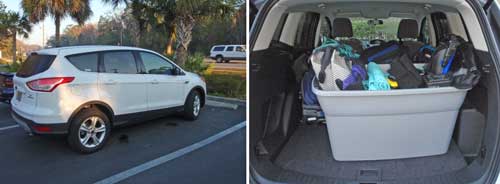
We took a small car GPS along and found it to be worthless. Even relatively new GPS systems will whine about their maps being outdated, and would we please update them by going on their website? Well, we can't while on the road, and the updates usually cost almost as much as a new GPS. Fortunately, as long as there's a signal, the iPad is far superior to most dedicated GPS systems anyway.
We stopped at a Walmart and bought the plastic bucket for the gear and a couple of bargain towels. And some snacks. Then checked in and nested at the very nice Crystal River Best Western.
On Thursday morning we first had our free breakfast at the Best Western where we saw our friend and Hotel Manager Frances who apparently had been at DEMA and seen me. It was nice catching up with her. Then we headed over to Manatee Tours USA, which is owned by our friends Charlie Slider and Terry Devich.
Charlie took us and three others to the Three Sisters area where a good number of manatees hung out in the roped-off sanctuary at the entrance to Three Sisters. The water was reasonably clear, though whirled up by too many people and too many manatee boats. The water level was also much lower than I had ever seen it, and when I tried to go up the channel to the Three Sisters basin, the current from it was so strong as to make swimming upstream impossible.
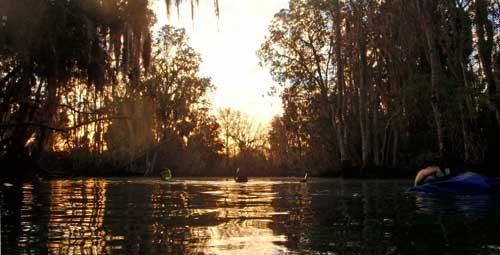
So I walked (without fins), but this time, Three Sisters was a let-down. The water level was so low that even swimming was barely possible. And whereas the area had looked like this wondrous archaic place when I saw it for the first time over six years ago, now it looked all different. Fish and Wildlife, which now apparently owns the land, had removed a large number of trees and only left a thin veneer around the basin standing. Then they put in a wooden walkway around the basin that looks intrusive and seems totally unnecessary. I didn't see a single person on it. I was later told that Fish and Wildlife, without consulting with any of the locals, had removed all vegetation that they consider "not native" and had also removed a lot of the rocks from the channel, with the result that the water now rushes in and out much too quickly. What a shame.
I was disappointed enough to consider passing on an invitation to go see the manatees again in the afternoon. Fortunately, I didn't as by now the tide had come in, making everything look better, though the beauty of Three Sisters is definitely and permanently marred. With the higher water level, lots of manatees were now in the The Sisters basin, hanging out, and eager to play. Lots of fun. But it's definitely a good idea to research the tide situation before booking.
After that we got tanks and weights at nearby Birds Underwater, with much thanks to the ever-helpful Bill Ostreich, owner of Birds. By that time it was almost dark and we headed up to Cedar Key where we'd booked a couple of nights at the charming historic Island Hotel. It's supposedly haunted, with different ghosts favoring different rooms. Ms. Bessie, a former owner and mayor of Cedar Key, was supposed to have on occasion haunted our truly wonderful room #129 with a big wide King size bed with corner posts, but she must have had the night off. After a good dinner at the Hotel's acclaimed restaurant, we quickly fell asleep. No hair drier, and the shower needed getting acquainted with. Perhaps it was haunted.
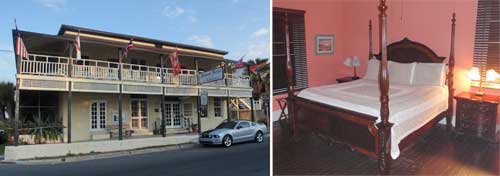
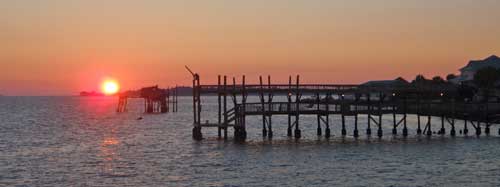
A visit to Manatee Springs State Park near Chiefland was scheduled for Friday. That's where the Catfish Hotel sink is, and the adjacent basin that empties into the Suwannee River. It was a leisurely one hour drive guided by Apple's much maligned mapping program that has always worked great for me. At the park you need to check in at the Ranger's station, pay $6 per car, fill out a form, and deposit your scuba certification card. Six bucks! What a great bargain.
We started with a quick tour through this really wonderful park. The sink's water level was fairly low, perhaps three or four feet lower than at our prior visits, and it was covered in a green layer of duckweed, as always.
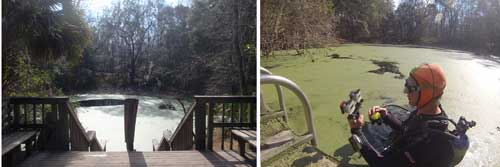
But before diving we walked down the raised wooden path along the river and to its mouth and saw a group of eight manatees. Then it was time to suit up and brave the descent into the murky looking green pond which, under a thin layer of duckweed, was the magical, wondrous underwater world I remembered it to be. The sun shone through some clear areas on the surface and illuminated the green cover like a giant lens. The effect was fantastic.
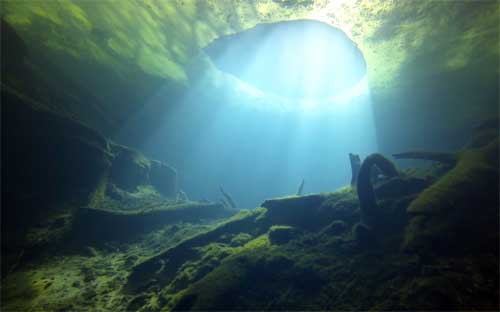
At the bottom of the sink under massive rock overhangs it was darker and I wish I could have brought along a light, but open water divers aren't allowed to take one with so they aren't tempted to go exploring the caves without proper training. At some point a group of three cave divers emerged from the dark, worked on their gear, dropped a tank each at the bottom of the sink at the cave entrance, then disappeared into the dark cave section that connects the sink with the basin a few hundred feet away. Carol and I surfaced, totally covered in duckweed. I couldn't stop laughing as we slung duck weed at each other. The stuff gets everywhere.
After a surface interval we walked over to the basin and did some more photography and testing with the GoPro cameras and filters we had brought along. I hung close by the cave exit where the spring blasted at me full force. I saw a flashlight and then some debris came flying out of the cave. But no diver emerged for a good ten more minutes. I began getting worried that he might have gotten stuck. But then the light appeared again, more debris, and then the caver. He was okay.
Here I need to relate a frustrating matter of diving logistics. Our 2013 Ford Escape rental had one of those giant FOBs that is, of course, not waterproof. The car did have keyless entry, but we did not have a code for it. The card with the code was supposed to be in the glove compartment, but it wasn't. So how do you go diving with a non-waterproof FOB?

Above: Once upon a time, all you needed to unlock and start a car was a metal key (left: 1969 Mercedes Benz), then came "fobs" (word origin unknown) to make it impossible to start or even "hot-wire" the car even with a key (2nd from left: 2004 Acura). Then increasingly expensive (and not waterproof) fobs replaced keys entirely (3rd from left: 2012 Prius), or became bulky contraptions with both key and electronics (right: 2011 Audi).
Carol suggested we stick it in one of those waterproof plastic boxes you hang around your neck when on boats and such, so that you have your room key and some money with you. Well, I did not trust those cheap plastic boxes with the FOB. Car rental companies charge a fortune if a FOB is lost or damaged. We also had one of those diver plastic drybags with multiple sealing lips. That looked like it might work, but I quickly saw that the water pressure would push in all the FOB's buttons, possibly crushing them or damaging the FOB with the keys remaining depressed for the duration of the dive. What if we put the drybag into the plastic box? Didn't fit.
I posed the question to other divers there. Some had older vehicles that still had real keys. One suggested to just put the key under the fender or hide it in some other place. I considered that, but then dismissed it because it didn't feel safe. I wondered whether the people who design cars ever consider that car owners might want to go swim, dive, kajak or go other places where a fragile, expensive electronic FOB will break.
We eventually found a solution. We put the FOB into a camera housing and took it with. The camera housing won't break or leak. But this also meant taking a housing on the dive, without the benefit of having the camera for which there was now no more room. And a housing designed to be more or less neutrally buoyant with a camera inside becomes an underwater helium balloon with just a key FOB inside. We tried other methods on this trip, too. Twice we asked the office at a dive site if they'd keep the key for us, and once we rented a locker.
Saturday was reserved for returns to Blue Grotto and Devil's Den near Williston, a leisurely one hour ride mostly on a totally straight road from Cedar Key. The last time we had been to Blue Grotto in June of 2009 we had the dive site all to ourselves. Not this time. When we arrived at 10:15 or so, there already were a good number of divers there, mostly classes. We caught up with owner Ed Paradiso, who is a great guy. He said he'd fill our tanks in two minutes. Two minutes. And that is exactly what he did. They weren't even warm. And there I thought filing tanks is always a lengthy affair.
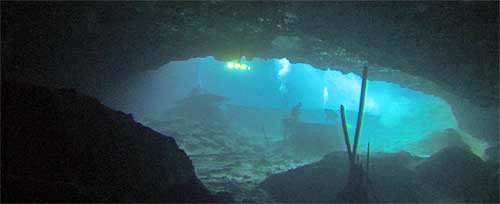
Despite the number of divers in the water, visibility was quite good. Not like it was when we had the grotto for ourselves, but more than good enough. There wasn't as much sun, and so the cavern itself looked quite dark at first. Carol and I soon left the brightly lit cavern part behind and descended down the slope into the cavelike darkness, all the way to the bottom at about 100 feet. The way back up had a totally different feel to it as now we saw the glimmer of blue high above us. That is how Blue Grotto got its name.
We then cruised around in the main chamber of the cavern, enjoying the clear water and watching all the divers do their thing. At times someone whirled up a big cloud of silt and it was easy to see how the visibility could go from great to bad in an instant. In the end it'd been a very enjoyable 55 minute dive. On the way out, Ed again provided superior service with another 2-minute tank fill.
Devil's Den is practically across the street from Blue Grotto. A short stretch on the highway, then a ways down a dirt road and there it is. Devil's Den. It looked exactly as I remembered it, and it wasn't even crowded. Manager Rowena was still there, as helpful and witty as ever.
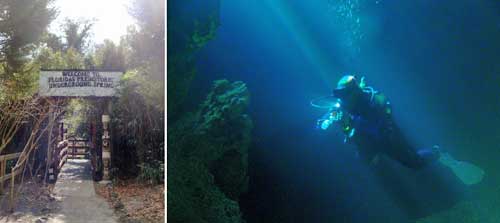
Carol and I got back into our wet and clammy gear, though the wonderfully sunny and pleasant weather made it easier, and it was hard to believe that this was the end of January. Amazingly, we didn't encounter any bugs either. Mosquitos and other insect pests are virtually a given in Florida, but not this time. Not in Crystal River, not in Cedar Key, not at Manatee Springs, and not at Blue Grotto and Devil's Den either.
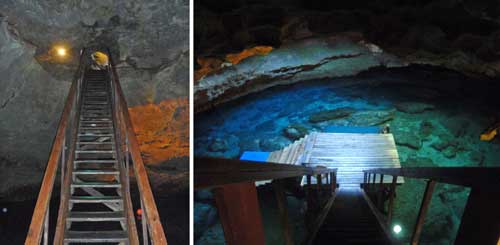
Descending the narrow stairs through the rock down into the cavern and then diving it reminded me again just what an incredible place Devil's Den is. It's also one of the greatest optical illusions ever; from above, the truly crystal clear water looks about five feet deep, if that, and it seems unlikely that this would be a satisfying place for diving. But delve underneath the surface and it's a totally different view. It's much deeper than it looks, and it feels much deeper than it actually is. That's because the wonderfully contoured limestone rock has so many nooks and crannies and swim-throughs that it absolutely feels like you're cavediving. And since Devil's Den is round and multi-layered, you can dive for a long time without ever seeing anything twice.
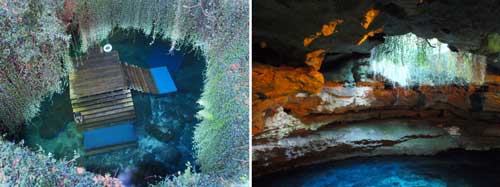
It's hard to believe that a cavern that is really only between 45 and 50 feet deep can feel this vast, mysterious and at times intimidating, but it does. In Blue Grotto, at 45 feet you're still in the bright, friendly main area full of light. In Devil's Den, descending between rocks to that depth feels like you're deep in a cave system, and the several closed-off areas that disappear into darkness only add to that feeling. The official word is always that those areas quickly peter out and don't go far, but it certainly feels different and I wouldn't be surprised if cave extended from Devil's Den for significant distances. As is, it's not clear where the cavern's clear spring water comes from and where it goes to. There is no discernible flow.
We also found a little red devil perched on top of a limestone outcropping. Perfect. We had not seen him before.
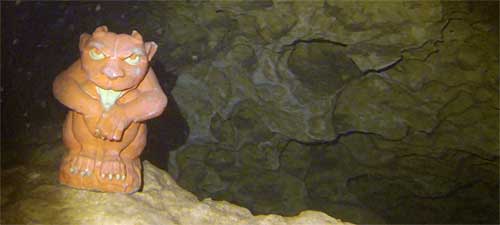
Two other things make Devil's Den special. One is the sunlight that streams down through the narrow, round opening of the cavern and illuminates the limestone in a wondrous dance of rays of light, also lighting up the wooden structure in the center. The other is the total absence of algae and almost total absence of silt. Instead, there's a bit of sand and if that gets whirled up by a careless fin, it quickly settles down again. This means Devil's Den is almost guaranteed to have fantastic visibility.
As usual, we had along a bunch of underwater camera equipment for testing. We're pretty good at it, but even after all these years of testing gear underwater, problems continue to catch us unawares. A camera ran out of space on its storage card and it turns out that it had quietly set itself to record at a much higher resolution than it had been set to. Batteries kept dying well before they should have. Housings fogged up without any physical reason, sometimes even with moisture munchers. Menus and operation turned out to be more cryptic than expected once underwater. Devices that are said to be waterproof weren't. Tools needed to assemble, adjust or take apart gear were missing. Scheduled shots and scenes either weren't possible or were forgotten.The list of what can go wrong is endless.
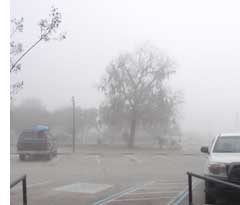 Sunday we went back to Rainbow River. We stayed at the Dinner Bell Motel (which doesn't actually have a restaurant) in Dunnellen, which was just fine. Grabbed a burger at a restaurant next door, prepped batteries and cameras, and woke up to .... a lot of fog. So much that we didn't leave the motel til 10:30 AM or so, then had breakfast at McDonald's, got a couple of things at the local Walmart, and only headed for K.P. Hole park when the sun finally burned through the fog almost noon.
Sunday we went back to Rainbow River. We stayed at the Dinner Bell Motel (which doesn't actually have a restaurant) in Dunnellen, which was just fine. Grabbed a burger at a restaurant next door, prepped batteries and cameras, and woke up to .... a lot of fog. So much that we didn't leave the motel til 10:30 AM or so, then had breakfast at McDonald's, got a couple of things at the local Walmart, and only headed for K.P. Hole park when the sun finally burned through the fog almost noon.
It cost US$5 per person to enter the meticulously maintained park, which is well worth it. We asked for Bret, the captain who was going to take us upriver in bis boat. Bret charged $10 per person for the service, also well worth it. We geared up and boarded the riverboat where we also found Bill, the prior owner. He'd ferried us upriver before. Soon we were up a few twists and bends and it was time to hit the water.
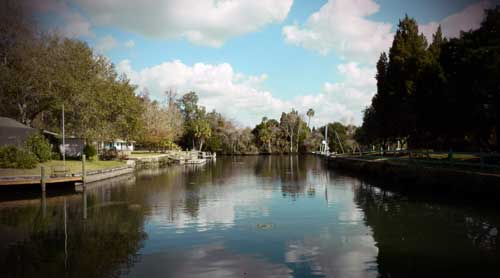
The Rainbow River originates not far from where we were dropped off in a spring. The water is about as clear as it gets in rivers. Depth varies from just three or four feet down to perhaps 25 feet. There is lush seagrass and all sorts of vegetation. The bottom is either sand or lime rock. The current varies, too, from almost none to quite a rush. The dive is mostly a drift dive, and one where you never know what's past the next river grass meadow. While the current generally shows the way, it's hard to figure out where you are in the river, but since it's so shallow you can just pop up and take a look around. Since there are boats on the river, divers need a dive flag. Carol used the Liquid Image HD324 video mask to tape the dive and so the task of handling the flag fell to me. With all the up and down there was a lot of paying our line and reeling it back in.
We ended up being underwater for over two hours, and the tanks still had plenty of air. You don't use a lot when your dive is this shallow. After the dive we enjoyed ice cream, sodas, and taking in the gorgeous vista of the river, all quiet and serene and beautiful, with Spanish Moss hanging off the trees. Another wonderful day. Then it was time to pack up the dive gear in our rental car and head back to the Best Western in Crystal River.
Om Monday morning, very bright and early we headed for Bird's for another Manatee tour, this time with the very personable Rhonda. It was still dark when we arrived at Bird's at 6:15 AM, and still quite dark when we left the dock after filling out releases, watching the mandatory Fish and Wildlife video and picked out wetsuits at 7. By the time we reached Three Sisters it was light, the water was clear and there were no other boats, so arriving early was a good thing.
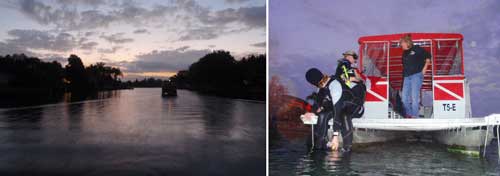
There was some flow out the channel to Three Sisters, but the water was still deep and swimming upstream was possible. Once in the Three Sisters basin, there were a lot of manatees to the right side of the basin. One, named Chester, was very playful and a real ham. The water was a pleasant 73 degrees Fahrenheit or so, and the 3-mil wetsuit I got at Bird's worked just fine. I didn't use fins and didn't need any.
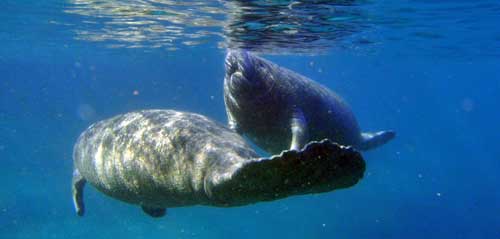
Back on the boat I felt cold enough to change back into my dry clothes, and didn't go back into the water at Jurassic Spring, which emanates from a 25-foot sink in front of a canal wall. Overall another pleasant experience with manatees, more good pics and video footage, and a chance to catch up with Bird, Chris and the rest of the gang.
And that was that. A few days away from the office grind, reacquainting ourselves with some of our favorite haunts, some glorious diving, and a good bunch of work with the cameras.
Posted by conradb212 at April 4, 2013 10:08 PM








